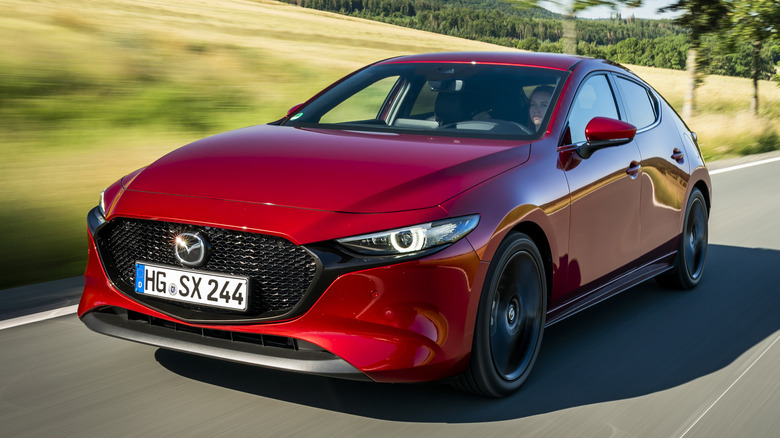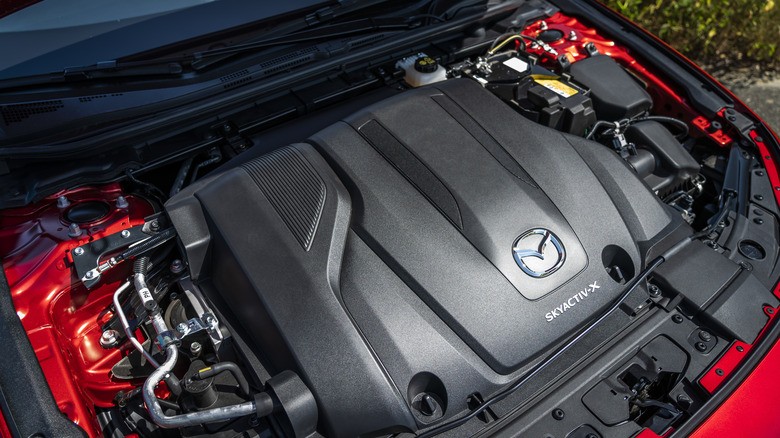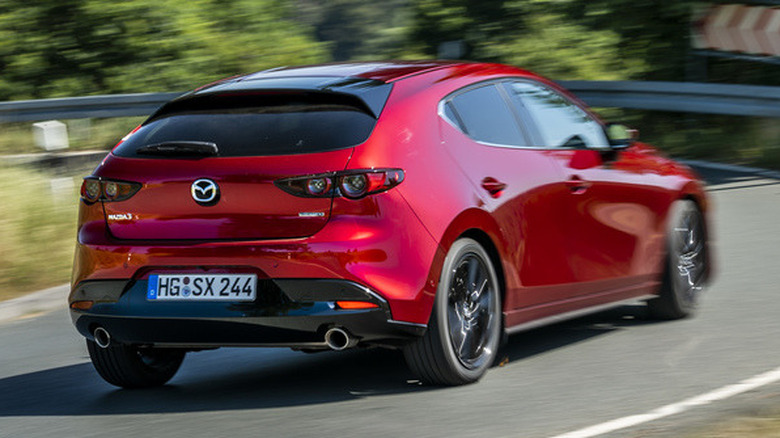What Happened To The Mazda Skyactiv-X Engine?
When Japanese automaker Mazda debuted the fourth-generation Mazda3 in 2019, it came with the brand's Skyactiv-X engine. This revolutionary powerplant combines the attributes of spark ignition and compression ignition, enabling it to produce more power while lowering emissions and fuel economy. Skyactiv-X was supposed to be the holy grail of internal combustion engines, the world's first to switch between compression ignition (like a diesel) and spark ignition (like a gas or petrol motor) to achieve unprecedented efficiency.
Mazda has cracked the homogenous charge compression ignition (HCCI) code, an engine technology that has puzzled legacy automakers since 2007. Mazda added a spark plug to the equation, and called it "Spark Controlled Compression Ignition" (SPCCI). As much as we love geeking over technical engineering terms here on SlashGear, the lowdown on Mazda's SPCCI technology is the engine's ability to run like a conventional spark-ignited gas engine during cold starts or higher engine speeds, and then switch to compression ignition like how a diesel engine operates when cruising or idling.
The cool thing about Skyactiv-X is the spark plugs are constantly igniting even when in compression ignition mode. Mazda found ways to use the spark plugs and fuel injection to compensate for various engine loads. It sounds great, but the Mazda3 with Skyactiv-X never made it stateside. Instead, Mazda is touting its newest Skyactiv-Z to replace the existing Skyactiv-G engines in most American Mazda cars and Skyactiv-X. Did Skyactiv-X fail to meet expectations? Or was it too late to fend off hybrids and plug-in hybrids (PHEVs)?
The Mazda Skyactiv-X powertrain is making waves in Europe
The Mazda 2.0-liter Skyactiv-X for Euro-bound Mazda3s made astounding numbers upon launch. It produced 178 horsepower and 165 lb-ft of torque using a stratospheric 16.3:1 compression ratio. Moreover, it achieves a highway mileage of 60 mpg, and a combined 50 mpg in the NEDC test cycle. However, it's critical to point out that the Skyactiv-X engine works in unison with a 24-volt Mazda M Hybrid system to deliver those impressive fuel economy numbers.
Mazda has since updated its e-Skyactiv X powertrain. It now has a lower 15.0:1 compression ratio, revised intake valve timing, improved software, and a quicker belt-driven starter generator to deliver more torque on demand. In addition, it now produces 183 horsepower and 177 lb-ft of torque, while delivering 36 to 47 mpg (6.5 to 5.0 l/100 km). The newest e-Skyactiv X is available for the Mazda3 and CX-30, mating to a six-speed manual or Skyactiv-Drive six-speed automatic gearbox. Both cars have standard front-wheel drive or an optional i-Activ all-wheel drivetrain.
Why Mazda's Skyactiv-X didn't appear in America
Industry experts said the current 2.0-liter Skyactiv-X engine lacks the power and oomph to impress American buyers. We agree with this assumption, although Mazda is hard at work developing an inline-six Skyactiv-X engine to address the horsepower concerns, per Motor1. Then again, Mazda has no official word about whether the six-cylinder Skyactiv-X will come to America. The brand was kind enough to introduce a turbocharged inline-six to the CX-70 and CX-90 crossovers, perhaps indicating what's coming from the brand.
The cost might also be related to why Mazda was gun shy in debuting the Skyactiv-X in the U.S. Mazda UK's online configurator lists the e-Skyactiv-X Mazda3 at a sub-£2,000 premium (about $2,500) over a standard Skyactiv-G engine, raising the base price from £27,600 to £29,755 for a 2025 Mazda3 Exclusive Line. Meanwhile, you can have a Mazda3 2.5 S for about $27,000 here in the U.S., and it has a more potent 191-horsepower 2.5-liter Skyactiv-G four-cylinder engine than the Skyactiv-X.
In the meantime, Mazda is touting the next-gen Skyactiv-Z four-cylinder engine as the future of the automaker's internal combustion lineup, which promises to be more efficient than Skyactiv-X. Mazda has yet to unveil details about Skyactiv-Z, but it did mention that the engine will debut in 2027.


